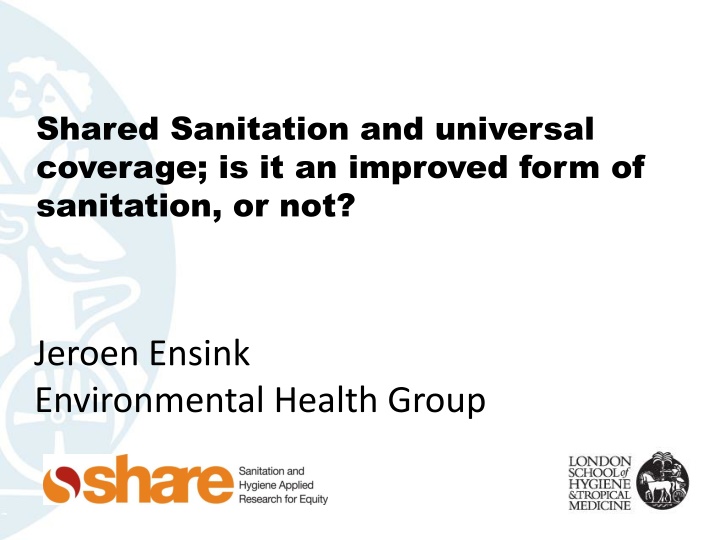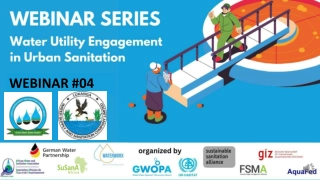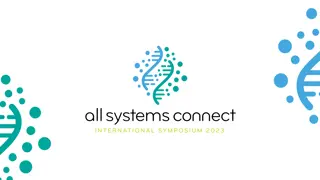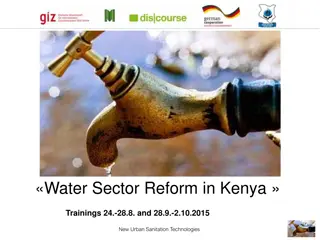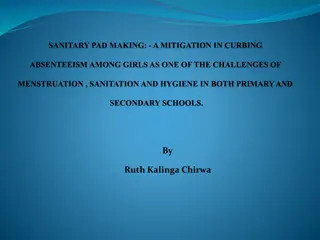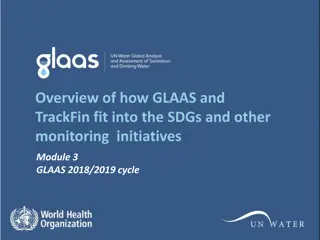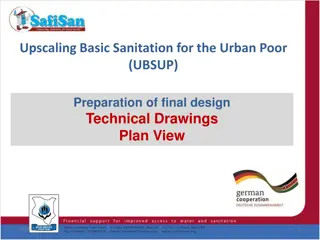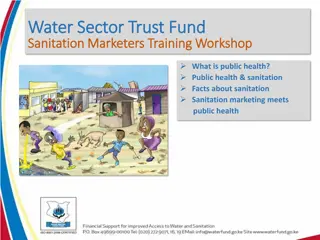Debate on Shared Sanitation: Improved or Not?
The discussion revolves around the classification of shared sanitation as improved or unimproved. WHO and UNICEF have a classification system where shared sanitation is considered unimproved due to concerns about cleanliness and accessibility. A proposed policy change by JMP seeks to include shared sanitation as improved if specific criteria are met. Current research analyzes the impact of shared sanitation on health outcomes, highlighting the ongoing debate in the field.
Download Presentation

Please find below an Image/Link to download the presentation.
The content on the website is provided AS IS for your information and personal use only. It may not be sold, licensed, or shared on other websites without obtaining consent from the author.If you encounter any issues during the download, it is possible that the publisher has removed the file from their server.
You are allowed to download the files provided on this website for personal or commercial use, subject to the condition that they are used lawfully. All files are the property of their respective owners.
The content on the website is provided AS IS for your information and personal use only. It may not be sold, licensed, or shared on other websites without obtaining consent from the author.
E N D
Presentation Transcript
Shared Sanitation and universal coverage; is it an improved form of sanitation, or not? Jeroen Ensink Environmental Health Group
WHO/ UNICEF JMP classification of sanitation IMPROVED UNIMPROVED - Flush/Pour flush toilet To piped sewerage system To septic tank To closed pit - Flush/Pour flush toilet To elsewhere TECHNOLOGY - Pit latrine without slab - Ventilated improved pit latrine - Hanging toilet or hanging latrine - Composting toilet - No facilities - Pit latrine with slab SHARING STATUS 1 2 or more households unimproved household
Sharing facilities Estimate 760 million people rely on public and other shared sanitation (JMP 2013) Globally, the number of users has increased by 425 million since 1990 increasing from 6 per cent of the global population to 11 per cent in 20 years Nearly a fifth of the population of sub-Saharan Africa and Eastern Asia reports using shared sanitation
Background Historically, public and other shared facilities those used by two or more households are excluded from the definition of improved sanitation regardless of the service level. According to the JMP, the reason stems from concerns that shared facilities are unacceptable, both in terms of cleanliness (toilets may not be hygienic and fully separate human waste from contact with users) and accessibility (facilities may not be available at night, or used by children, for instance).
Proposed Policy Change JMP is considering a revision to is policy that would include shared sanitation as improved and thus scored toward the post-MDG targets if the facilities meet the required levels of service and are shared among no more than 5 families or 30 persons, whichever is fewer, where the users are known. This proposed change is based on advice from an expert committee. Minutes of Sanitation Task Force, December 2012.
Current Research on Shared Sanitation Analysis of data from GEMS case-control study to assess odds of severe diarrhoea based on number of households sharing latrines (Baker et al.) Analysis of JMP data to map geographic and demographic scope of shared sanitation (Heijnen et al.) Analysis of JMP data to investigate association between shared sanitation and diarrhoea (Fuller et al.) Systematic review of shared sanitation versus individual household latrines (Heijnen et al.) Field investigation of shared sanitation versus individual household latrines in Indian slums (Heijnen et al.)
Geographic and Demographic Scope of Shared Sanitation Extracted data on shared sanitation from the most recent national household surveys of 87 countries (DHS, MICS, LSMS) Extracted data from the same surveys on selected covariates that may be associated with reliance on shared sanitation: urban/rural setting, wealth quintile, number of households sharing a latrine and the number of households without any latrine facilities. We described and mapped the prevalence of shared sanitation by country and region and explored associations between the specified covariates and reliance on shared sanitation versus individual household latrines.
Geographical Scope of Shared Sanitation 90 Percentaage of households sharing sanitation facilities Ghana 80 Sierra Leone Liberia 70 Togo Benin Madagascar Congo (Brazzaville) Guinea 60 Cote d Ivoire Kenya Burkina Faso Niger Nigeria 50 Congo, DR Gabon Uganda Zimbabwe Africa Malawi Guinea-Bissau Gambia Swaziland Mali CAR2 40 Lesotho Ethiopia Zambia Tanzania Cameroon South East Asia Senegal Mauritania 30 Namibia Western Pacific Rwanda Burundi Americas 20 Sao Tome and Principe Mozambique Djibouti 10 Eastern Mediteranean Europe 0
Urban/Rural Prevalence of Shared Sanitation by Region 60 % of households reporting sharing sanitation facilities 50 Urban Rural 40 30 20 10 0 Africa Americas South East Asia Western Pacific Europe Eastern Mediterranean
Systematic Review Shared sanitation defined as any type of facilities intended for the containment of human faeces and used by more than one household, but excluded public facilities. Health outcomes included diarrhoea, helminth infections, enteric fevers, other faecal-oral diseases, trachoma and adverse maternal or birth outcomes. Studies were included regardless of design, location, language or publication status. Searched 19 electronic databases and hand-searched relevant conference proceedings, contacted researchers and organizations working in the field, and checked references from identified studies Studies were assessed for methodological quality using the STROBE guidelines.
Results Nineteen studies covering 19 countries met the review s inclusion criteria. Studies show a consistent pattern of increased risk of adverse health outcomes associated with shared sanitation compared to individual household latrines. Diarrhoea Helminth Infection Adverse birth outcomes
Helminth Infection (6 comparisons) Number of persons per toilet was positively associated with Ascaris lumbricoides infection intensity (Tsushika 1995). Sharing toilets with another family increased the risk of intestinal helminths (adjusted OR 1.95[95% CI 1.38-2.75]) and from protozoan parasites (adjusted OR 1.65 [95% CI 1.06-2.58]) (Mahfouz 1997) Using a community latrine rather than a private latrine increased for S. stercoralis infection among adults (adjusted OR 2.72 [95% CI 1.57-4.72) and children (adjusted OR 2.43 [95% CI 1.35-4.38]), but not for those sharing with neighbors (Hall 1994) Sharing latrine with other families and the absence of piped water inside the house were associated with a significantly higher intensity of infection for A. lumbricoides (p<0.001) and for T. trichiura (p<0.05) but not for S. mansoni (Curtale 1998) Phiri et al. found no statistically significant risk associated with A. lumbricoides, hookworm, T. trichiura, or S. stercoralis infection and shared latrine facilities
Other Health Outcomes Increase risk of poliomyelitis in an outbreak in Taiwan among those sharing toilets with other families (OR 4.0 [95% CI 1.9-8.3]) (Kim- Farley 1984). Adverse birth outcomes associated with shared sanitation Prematurity (adjusted OR 1.26 [95% CI 1.07-1.48]) and and low birth weight (adjusted OR 1.27 [95% CI 0.98-1.65]) (Olusana 2010) Perinatal death among women, antepartum fetal deaths (adjusted OR 1.62 [95% CI 1.28-2.03]) and perinatal death (adjusted OR 1.41 [95% CI 1.21-1.64]) (Golding 1994) hospital admissions for children (Munoz 1992) No increased risk of trachoma from shared latrines (adjusted OR 0.95 [95% CI 0.55-1.67]) (Montgomery 2010)
Conclusions A large and growing population relies on shared sanitation, particularly in urban settings in Africa and Asia Evidence to date does not support a change of existing policy of excluding shared sanitation from the definition of improved sanitation used in international monitoring and targets. However, such evidence is limited, does not adequately address likely confounding, and does not identify potentially important distinctions among types of shared facilities. Further research is necessary to determine the circumstances, if any, under which shared sanitation can offer a safe, appropriate and acceptable alternative to individual household latrines.
Hygiene along the sanitation ladder Selection of >350 latrines Divided over different groups Rural vs Urban Improved vs Unimproved Shared vs Family latrine Different technology Impact of seasonality Comparative sample within the household Different transmission routes Hand contact point sampled for presence and concentration of E. coli Soil samples analysed for helminths Fly catches within latrines
E. coli at point of hand contact
Risk factors E. coli Higher levels of contamination in dry season (10 vs 37 E. coli/100 ml) The higher the number of users the cleaner the facility Mutivariate: presence of a slab, and season significant Helminths No correlation between type of latrine and concentrations in courtyard 60% of latrines without a slab positive, 100% of latrines with a cracked slab Flies Concentrations low Urban latrines produce more flies and higher levels of sharing result in more fly Absence of a roof a key risk factor
Conclusions Pit latrines without a slab can pose a risk for hookworm infection Need to come-up with solutions to improve the simple pit latrine (without a slab) Use and management seem more important in hygiene of a latrine than technology alone Shared latrines should be included as an improved form of sanitation in new SDGs
